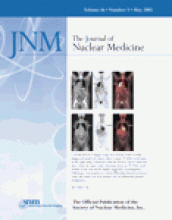Tulchinsky and Peters outline the development of leukocyte receptor-binding radiotracers and describe requirements for ideal infection and inflammation imaging agents.
Sciagrà and colleagues report on the use of gated SPECT to assess the effect of abciximab therapy on outcomes after myocardial reperfusion in patients with acute myocardial infarction.

Slomka and colleagues apply delayed-enhancement MRI as a validation tool to measure the accuracy of a novel automated myocardial perfusion 201Tl SPECT quantification method, based on normal limits, for detection and sizing of infarcts.
Fricke and colleagues evaluate the enhanced accuracy of a SPECT/low-dose CT device in myocardial perfusion scintigraphy and compare results with those from 13N-ammonia PET.
van Dyck and colleagues use 123I-β-CIT to investigate the relationship between striatal dopamine transporter (DAT) protein availability and a polymorphism of the gene that codes for DAT and discuss the implications of their findings for neuropsychiatric studies.
Ishimori and colleagues report on the detection of unexpected 18F-FDG-avid additional primary malignant tumors, as well as false-positive results, in patients being evaluated by whole-body 18F-FDG PET/CT for known or suspected malignancies.
Israel and colleagues study the nature and significance of unexpected focal 18F-FDG uptake localized by PET/CT within the gastrointestinal tract in a retrospective review of more than 4,000 patients.
Henze and colleagues describe the pharmacokinetic modeling of the high uptake of 68Ga-DOTA-TOC in meningiomas and offer data that may serve as a basis for the use of PET in radiotherapy planning and subsequent monitoring of somatostatin receptors.
Yen and colleagues evaluate the sensitivity and prognostic significance of whole-body 18F-FDG PET for follow-up evaluation of recurrences and metastases in patients with nasopharyngeal carcinoma.

Yen and colleagues detail a study evaluating the utility of PET in staging untreated squamous cell carcinoma of the buccal mucosa and compare the results with those from CT and MRI and histopathology.
Zitzmann and colleagues report on a novel bacterial peptide display system as an alternative to phage peptide display for the isolation of new prostate tumor-specific peptides.
van Eerd and colleagues study the pharmacodynamics of 111In-DPC11870 to determine the mechanism of accumulation of the radiolabeled LTB4 antagonist in infectious and inflammatory foci in an animal model.

Takei and colleagues elucidate the relationship between apoptosis and glucose utilization during cancer chemotherapy using 99mTc-annexin V and 18F-FDG and compare the uptake of these tracers in a rat tumor model.
Semnani and colleagues assess the efficacy of targeting of lung metastases in mice with various formulations of the radioiodinated thymidine analog 123I-IUdR/125I-IUdR.

Tait and colleagues look at ways in which changes in membrane-binding affinity, molecular charge, and method of labeling affect the biodistribution of 99mTc-annexin V in normal and apoptotic tissues.
Zhou and colleagues describe the potential of dual-tracer small-animal SPECT in simultaneous imaging of 99mTc-sestamibi to assess myocardial perfusion and of 111In-labeled stem cells to delineate stem cell grafts in regions of infarct.
Maina and colleagues compare the biologic profiles of 99mTc-demobesin 1 and 111In-Z-070 using various gastrin-releasing peptide receptor (GRP-R)-expressing tissues of human and animal origin and discuss the implications for the development of bombesin analogs for GRP-R-targeting applications.
Altmann and colleagues visualize functional protein-to-protein interaction as thyroid transcription factors induce reporter gene expression in rat hepatoma cells and report on the ability of these factors to induce endogenous thyroid-specific gene expression and iodide accumulation in nonthyroid tumor cells.
Dewaraja and colleagues describe the accuracy of 131I activity quantification and absorbed dose estimation when patient-specific, 3-dimensional methods are used for SPECT reconstruction and absorbed dose calculation and discuss the implications for advances in radioimmunotherapy.
Vallabhajosula and colleagues evaluate the potential value of several factors in predicting myelotoxicity associated with 90Y- and 131I-labeled monoclonal antibody therapy in patients with prostate cancer.
Brasse and colleagues use 3-dimensional whole-body PET simulations and phantom studies to investigate how gains in noise equivalent count rates from a noiseless random coincidence estimation method are translated to improvements in signal-to-noise ratio, with accompanying potential for reduction in scan duration.
Seo and colleagues evaluate an iterative reconstruction algorithm using SPECT/CT data from phantoms and 111In-capromab pendetide studies to assess the utility of a commercial SPECT/CT system in imaging of postprostatectomy patients at risk for residual or recurrent disease.
Cheng and colleagues describe the use of matrix-assisted laser desorption/ionization time-of-flight mass spectrometry as a potential tool for high-throughput screening and characterization of molecular imaging probes or drug design and development.
Froidevaux and colleagues evaluate the receptor-binding potency and biodistribution of radiolabeled analogs of α-melanocyte-stimulating hormone in a mouse melanoma model.
ON THE COVER
In patients with known cancer, work-ups often focus on the primary disease, and incidental coexistence of another primary malignant lesion can be missed. The prevalence of additional primary neoplasms is substantial. Whole-body PET with 18F-FDG has been used successfully and with increasing frequency in the evaluation and clinical management of an expanding number of neoplasms. Reports also indicate that 18F-FDG PET has the potential for cancer screening and can detect new malignant tumors in a small fraction of asymptomatic individuals. Because PET/CT allows precise determination of the location of 18F-FDG uptake, whole-body studies may be of value in the detection of unexpected additional primary malignant tumors in patients with known or suspected malignancies.








